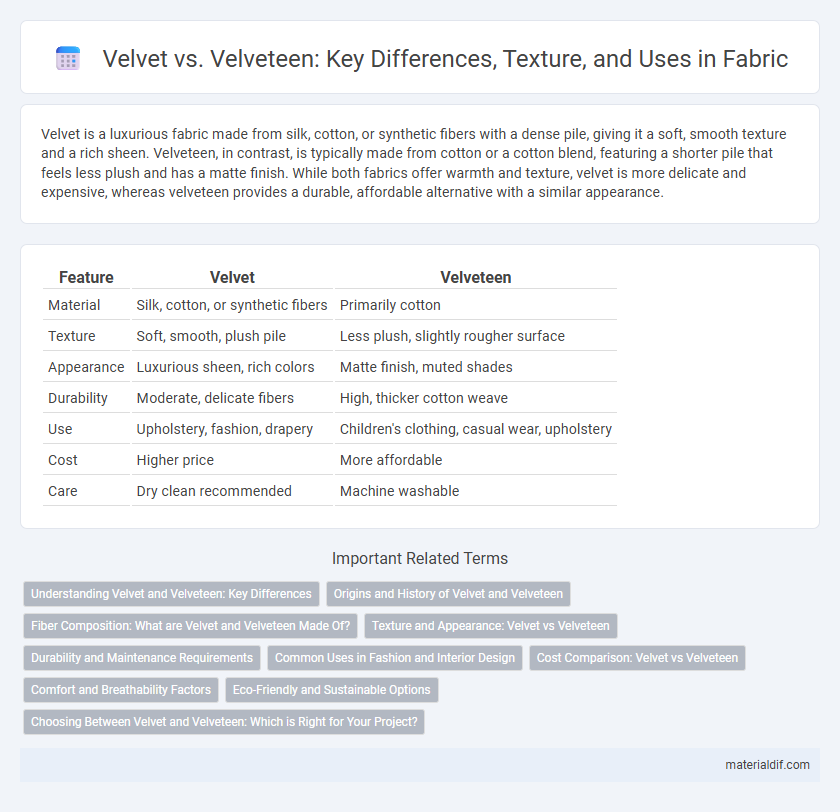Velvet is a luxurious fabric made from silk, cotton, or synthetic fibers with a dense pile, giving it a soft, smooth texture and a rich sheen. Velveteen, in contrast, is typically made from cotton or a cotton blend, featuring a shorter pile that feels less plush and has a matte finish. While both fabrics offer warmth and texture, velvet is more delicate and expensive, whereas velveteen provides a durable, affordable alternative with a similar appearance.
Table of Comparison
| Feature | Velvet | Velveteen |
|---|---|---|
| Material | Silk, cotton, or synthetic fibers | Primarily cotton |
| Texture | Soft, smooth, plush pile | Less plush, slightly rougher surface |
| Appearance | Luxurious sheen, rich colors | Matte finish, muted shades |
| Durability | Moderate, delicate fibers | High, thicker cotton weave |
| Use | Upholstery, fashion, drapery | Children's clothing, casual wear, upholstery |
| Cost | Higher price | More affordable |
| Care | Dry clean recommended | Machine washable |
Understanding Velvet and Velveteen: Key Differences
Velvet is a luxurious fabric made from silk, cotton, or synthetic fibers, characterized by its soft, dense pile and smooth texture, often used in high-end fashion and upholstery. Velveteen, typically made from cotton, features a shorter pile and a less lustrous, more matte finish, providing a more affordable and durable alternative to velvet. The key differences lie in their fiber content, pile length, and sheen, which affect their appearance, feel, and appropriate uses.
Origins and History of Velvet and Velveteen
Velvet originated in the Middle Ages, initially produced in luxurious European workshops using silk fibers that made it a symbol of nobility and wealth. Velveteen developed later as a cotton-based alternative designed to mimic velvet's soft texture but offered at a more affordable price. The historical distinction lies in velvet's silk origins tied to royal attire, while velveteen emerged from industrial advances making plush fabrics accessible to the broader population.
Fiber Composition: What are Velvet and Velveteen Made Of?
Velvet is traditionally made from silk fibers, but modern variants often incorporate cotton, polyester, or a blend of synthetic fibers, giving it a smooth, luxurious texture with a distinct sheen. Velveteen, in contrast, is composed primarily of cotton or cotton blends, featuring a shorter pile that creates a matte finish and a denser, stiffer fabric. The fiber composition directly influences their durability, softness, and drape, making velvet ideal for elegant garments and upholstery, while velveteen suits more casual or structured uses.
Texture and Appearance: Velvet vs Velveteen
Velvet features a dense, plush pile with a luxurious sheen, creating a smooth and reflective surface that enhances its rich texture. Velveteen has a shorter pile made from cotton, resulting in a matte finish and a slightly stiffer, less lustrous appearance. The difference in fiber content and pile length gives velvet a more opulent and soft feel, while velveteen offers durability with a more muted, textured look.
Durability and Maintenance Requirements
Velvet, made from silk, cotton, or synthetic fibers, offers greater durability due to its dense pile and strong weave, making it suitable for high-traffic upholstery. Velveteen, composed primarily of cotton, tends to wear faster and requires more frequent maintenance, including gentle washing and careful handling to prevent crushing the pile. Both fabrics demand regular brushing or steaming to maintain their soft texture, but velvet's resilience makes it a longer-lasting choice for furniture.
Common Uses in Fashion and Interior Design
Velvet is primarily used in high-end fashion such as evening gowns, blazers, and luxury dresses due to its rich texture and sheen, making it a popular choice for statement pieces and formal wear. Velveteen, with its cotton base and softer pile, is favored in interior design for upholstery, draperies, and cushions because it offers a plush look with greater durability and ease of care. Both fabrics bring elegance and warmth to spaces and wardrobes, but velvet's lustrous finish is preferred for sophisticated appeal, while velveteen suits casual, everyday use.
Cost Comparison: Velvet vs Velveteen
Velvet typically costs more than velveteen due to its luxurious fibers such as silk or high-quality cotton and more intricate weaving process. Velveteen, made from cotton or cotton blends with a shorter pile, offers a more affordable alternative for upholstery and apparel. Budget-conscious buyers often choose velveteen for its velvet-like appearance at a fraction of the price.
Comfort and Breathability Factors
Velvet is a plush fabric made from silk or synthetic fibers, offering superior softness and a luxurious feel, but it tends to be less breathable and warmer due to its dense pile. Velveteen, crafted primarily from cotton, provides a softer, more breathable alternative that is ideal for comfort in moderate to warm climates, as its lighter weave allows better air circulation. The choice between velvet and velveteen depends on the need for insulation versus breathability, with velvet excelling in warmth and velveteen favored for comfort in everyday wear.
Eco-Friendly and Sustainable Options
Velvet, typically made from silk or synthetic fibers, often involves energy-intensive production processes, while velveteen, composed mainly of cotton, offers a more eco-friendly alternative due to its natural fiber content and biodegradability. Organic cotton velveteen enhances sustainability by reducing pesticide use and soil degradation, making it a preferred choice for environmentally conscious consumers. Choosing velveteen over traditional velvet supports lower environmental impact through renewable resources and improved lifecycle biodegradability.
Choosing Between Velvet and Velveteen: Which is Right for Your Project?
Velvet, made from silk, cotton, or synthetic fibers, offers a plush texture and rich sheen ideal for luxurious upholstery and formal garments, while velveteen, typically cotton-based with a shorter pile, provides a matte finish and greater durability suited for casual wear and home decor. Consider velvet for projects requiring opulence and softness, whereas velveteen is preferable when affordability, ease of care, and a sturdier fabric are priorities. Selecting between velvet and velveteen depends on the desired texture, appearance, durability, and budget constraints of your specific project.
Velvet vs Velveteen Infographic

 materialdif.com
materialdif.com